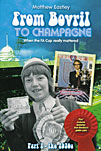 When The FA Cup Really Mattered
When The FA Cup Really Mattered
Matthew Eastley
Authorhouse, £13.99
Reviewed by Roger Titford
From WSC 283 September 2010
Bliss was it to be alive as a fan in the 1970s, even with a dodgy haircut and platform shoes – that's Matthew Eastley's (born in 1966) reasonable premise. His focus is on ten FA Cup finals as seen through the fans' eyes. I saw nine of them on telly and one at Wembley and this book is a decent memory-jerker that rings true despite, I suspect, some creative embellishments of his contributors' stories.
Over 30 years on from the final I attended I've only got half a dozen memories of the day, including the, apparently not unusual, practice of concealing my precious ticket in my shoe and seeing a tout flee, squealing like an animal, from pursuing fans. But, unlike Eastley's witnesses, I can't access a vision of what clothes they were wearing. There's plenty of name-checking of brands like Sta-Prest, Sunblest and Colt 45 and references to key political events of the time which I would find much harder to place in time alongside the matches.
From Bovril to Champagne has a simple structure of one chapter per season with each chapter looking back on the finalists' progress to Wembley and a detailed description of the fans' journey to and experience of the big day. A few of these stories have a genuine human interest outside football and Eastley manages this material well without getting mawkish. Not only has he worked hard in getting these fresh perspectives but it sounds as if he has also watched recordings of all the finals, including gems from the commentaries such as David Coleman's inexplicable "Goals pay the rent and Keegan gets his share" outburst of 1974.
Eastley is not shy of pointing out the deficiencies of the 1970s – indeed he's a little too ready to condemn. Who's to say platform shoes will seem any more ridiculous than Twitter in 30 years? There's more about crowd violence than I would have expected, there's plenty about the ubiquitous drinking culture on coaches and trains but, most of all, there is lots about ticket scarcity. With increased allocations and, I believe, fairer distribution some of the sting about Cup final tickets has disappeared – and with it perhaps some of the distinctive magic of the Cup?
Eastley does not offer a view on this or any of the major themes about the decline of the Cup. From Bovril to Champagne is billed as "Part One" with presumably the 1980s – Wimbledon, Coventry and QPR – to come as Part Two. It would be good to conclude that book with a more analytical chapter. There are two other minor issues with part one. Firstly, Eastley's style and the repetitive nature of the content make this a book to dip into, not read through. Secondly, if you're interested in the Fulham perspective on 1975 there isn't one, but there is a rather fine piece from the West Ham angle.